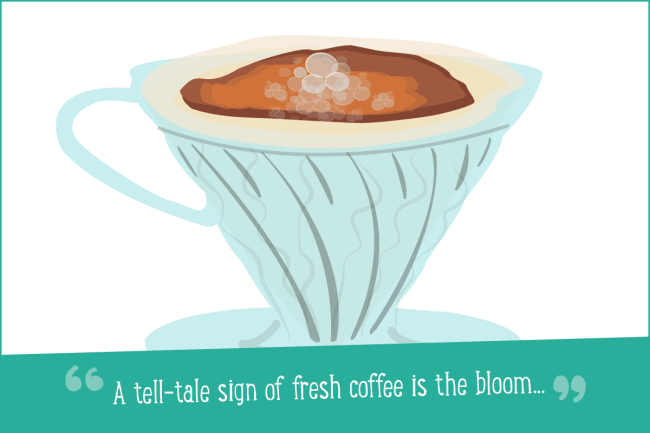If you make coffee following our simple brew guides, you may have read about the “bloom”. This little jargon nugget actually refers to that magical moment when hot water and coffee meet, creating a blooming effect. We fully endorse a jargon-free coffee-drinking experience here, but this moment is kind of cool, so let’s look into it in a little more detail…
Blooming occurs in each brew method, with the exception of espresso, and it’s really key to enjoying a balanced, flavourful cup of coffee. Understanding exactly what’s going on when your coffee blooms takes a little bit of science and just a dash of coffee knowledge. So, join us fearless coffee conquerors, as we bust this coffee jargon apart, one sub-heading at a time:
The Roast Like so many aspects of your daily cup of coffee, it all starts with the roast. After green coffee beans are roasted they begin to discharge carbon dioxide. As the CO2 seeps away it takes some of the more volatile flavour compounds, leaving your coffee tasting flat and woody. The roasted beans will steadily continue this “degassing” process until they are no longer fresh. So the more CO2, the better the bloom and the fresher the coffee. Simple, right?
Grinding Ground coffee degasses faster. This is because the increased surface area of the beans allows more room for the gas to escape. While plenty of Pact customers grind their own beans, just as many don’t. That doesn’t matter though, we grind them at the last possible moment to ensure they are as fresh as possible when they land on your doorstep.
Freshness Have you noticed how each bag Pact coffee is airtight and resealable? Well, this is to preserve the freshness of your coffee. Factors such as time, exposure to air and grinding will increase the rate of degassing. You’ll get a perfect bloom by keeping these elements at bay.
The Brew So you’ve kept your coffee fresh to guarantee the best blooming conditions. Next comes the part where the magic happens: It’s time to brew.
Submerging fresh grounds in hot water amplifies the degassing process, forcing the carbon dioxide from the coffee. As it escapes, the force of the gas pushes the water, causing the mixture to puff up and bubble. This reassures you that the coffee you’re drinking is at its best.
So there we have it, next time you see your coffee bubble and froth something marvellous and delicious is actually happening. As ever, if you have any thoughts or questions about any of this feel free to pop a comment below…






